rosemary-garlic no-knead bread
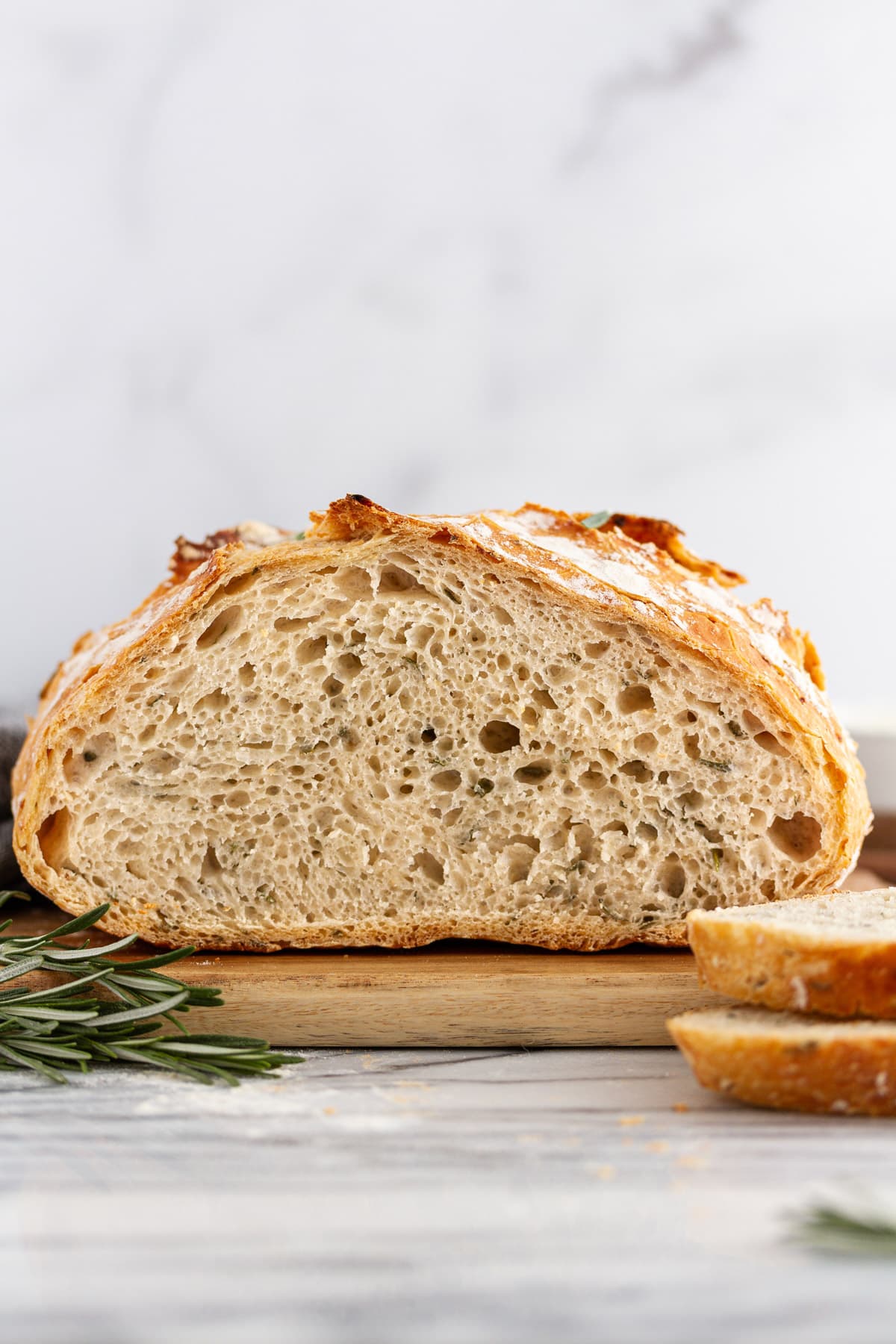
Ready to bake the tastiest bread you’ll ever make at home? This Rosemary-Garlic No-Knead Bread is soft on the inside, crisp on the outside and flecked with fresh rosemary and minced garlic throughout so every bite is oh-so-flavorful. Oh, did I mention it comes together with just five ingredients? Let’s bake!
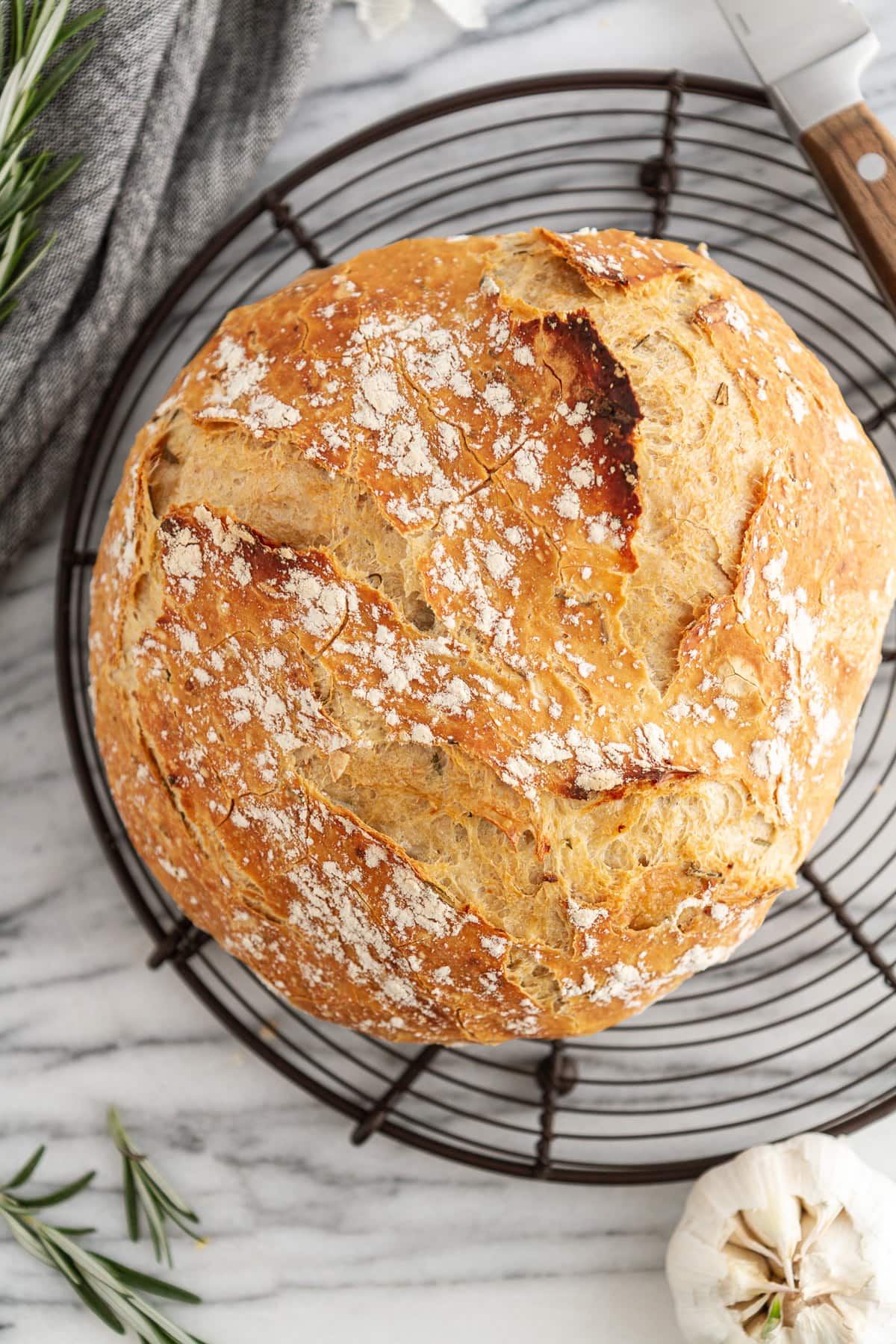
Rosemary-Garlic No-Knead Bread Recipe
Well my friends, here it is: The best bread I’ve ever baked at home to date. Based on your overwhelming response of support to my query on Instagram (which was: “Should I make this rosemary-garlic no-knead bread?”), I took on the task and the rest is history.
This recipe is effectively my classic and ever-popular No-Knead Dutch Oven Bread 2.0, with elevated flavor mix-ins of fresh rosemary and garlic. And we’re STILL clocking in at five ingredients, so… basically, there are no reservations to my wholehearted recommendation that you get this bread. So to speak.
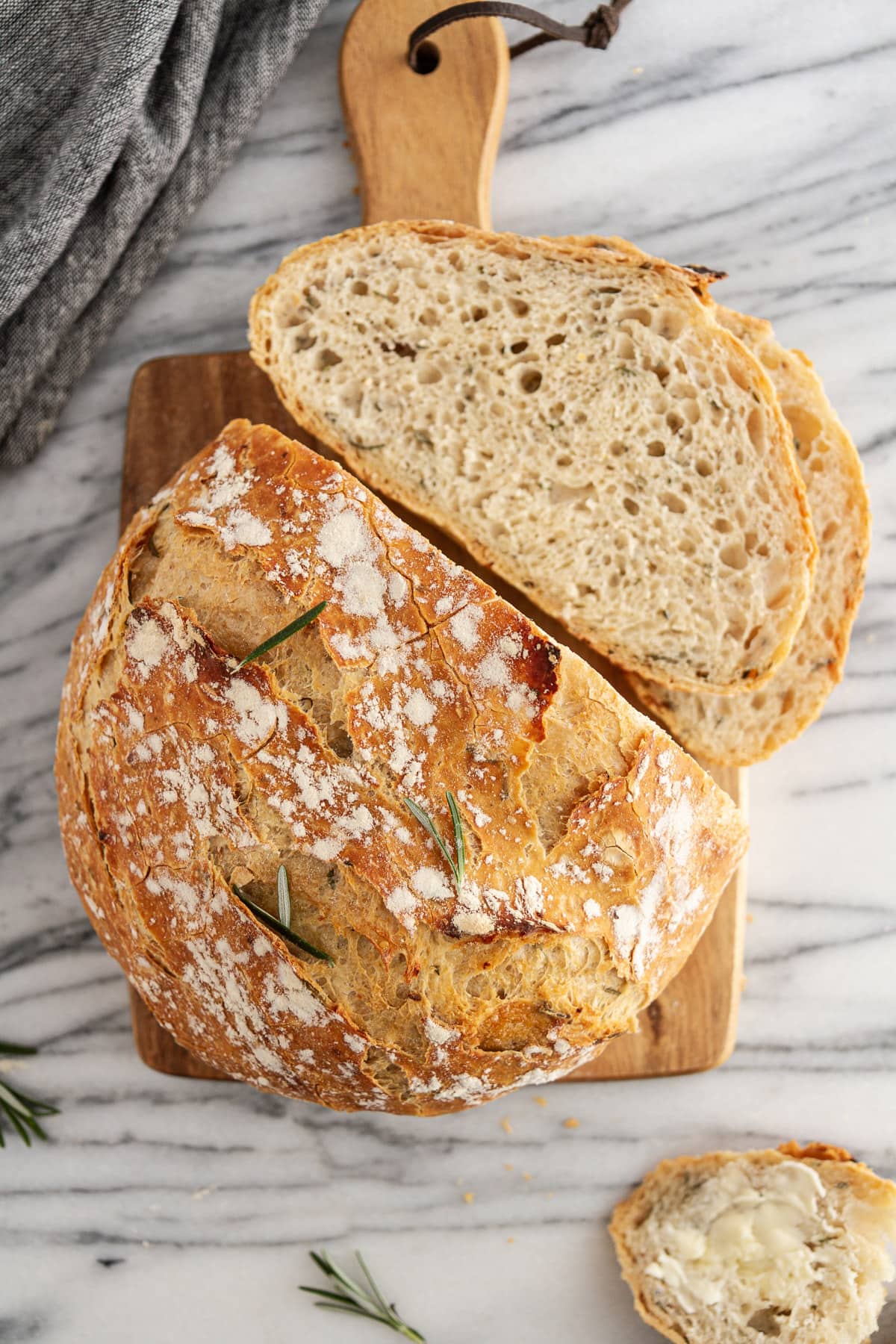
How to Make Rosemary-Garlic No-Knead Bread
OK but how, HOWWW do you make no-knead bread? Guys, it’s so easy. If you haven’t made it before, stop everything you’re doing and get yourself a Dutch oven. Once that box is checked off, grab the ingredients you’ll need for this recipe: All-purpose flour, sea salt, active dry yeast, fresh rosemary and garlic (I’ll assume you have water on hand). Mix the flour, salt and yeast, then stir in the rosemary and garlic. Pour in the warm water, give everything a good stir, and let it take a very long, glorious nap overnight.
The next day, the dough should have risen considerably, with a flattened top covered in bubbles. Shape the dough into a round loaf, transfer it to a preheated Dutch oven (see the recipe Notes for more info on this part!), and let it bake. In just one hour, you’ll have a perfectly puffed, round, golden-brown loaf of homemade bread and your kitchen will smell like fresh rosemary and warm carbs and you’ll be the happiest you’ve ever been in life. True facts.
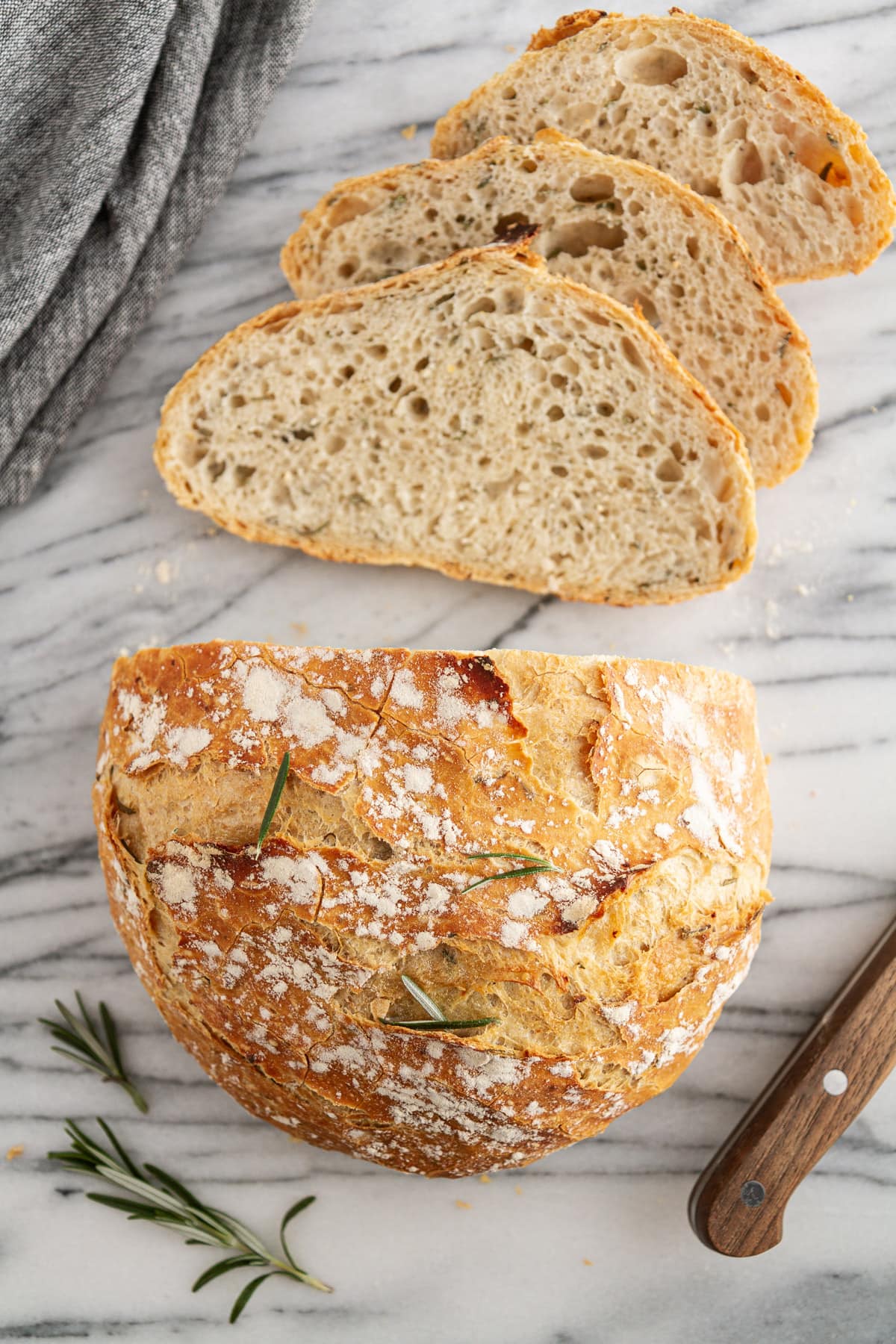
Tips for the Best-Ever No-Knead Bread
Honestly, when it comes to no-knead bread, there’s not much advice to give because it’s SO easy and essentially foolproof. But to make 100% sure we all get the best homemade bread we all love and deserve, here are some tips!
- Placing the parchment in the Dutch oven with the bread is optional IF you have an enamel-coated Dutch oven. I always bake my bread with parchment paper because I find it easier to transfer it to a screaming-hot pot this way, but you do you. If you have a non-enamel-coated Dutch oven, the parchment paper is necessary to avoid sticking and burning.
- Feel free to adjust the amounts of rosemary to taste! If you’re a major rosemary lover, add an extra tablespoon or two of chopped fresh rosemary to the dough.
- I know there is that irresistible temptation to tear right into this bread right outta the oven, while it’s hot and delicious. But if you do, be warned: It might end up a little gummy. So, I like to let the bread cool until it’s just warm, then slice into it. And then I slather it liberally in salted butter. It’s just the right thing to do here.
- For the sake of brevity, I’ll stop there with tips, but I’ve got a few extras to pay attention to in the Notes section of the recipe below!
Friends, countrymen, and fellow carb lovers, do I even need to say it? Let’s get this bread! If you love dessert like me, make this Quick Banana Bread!
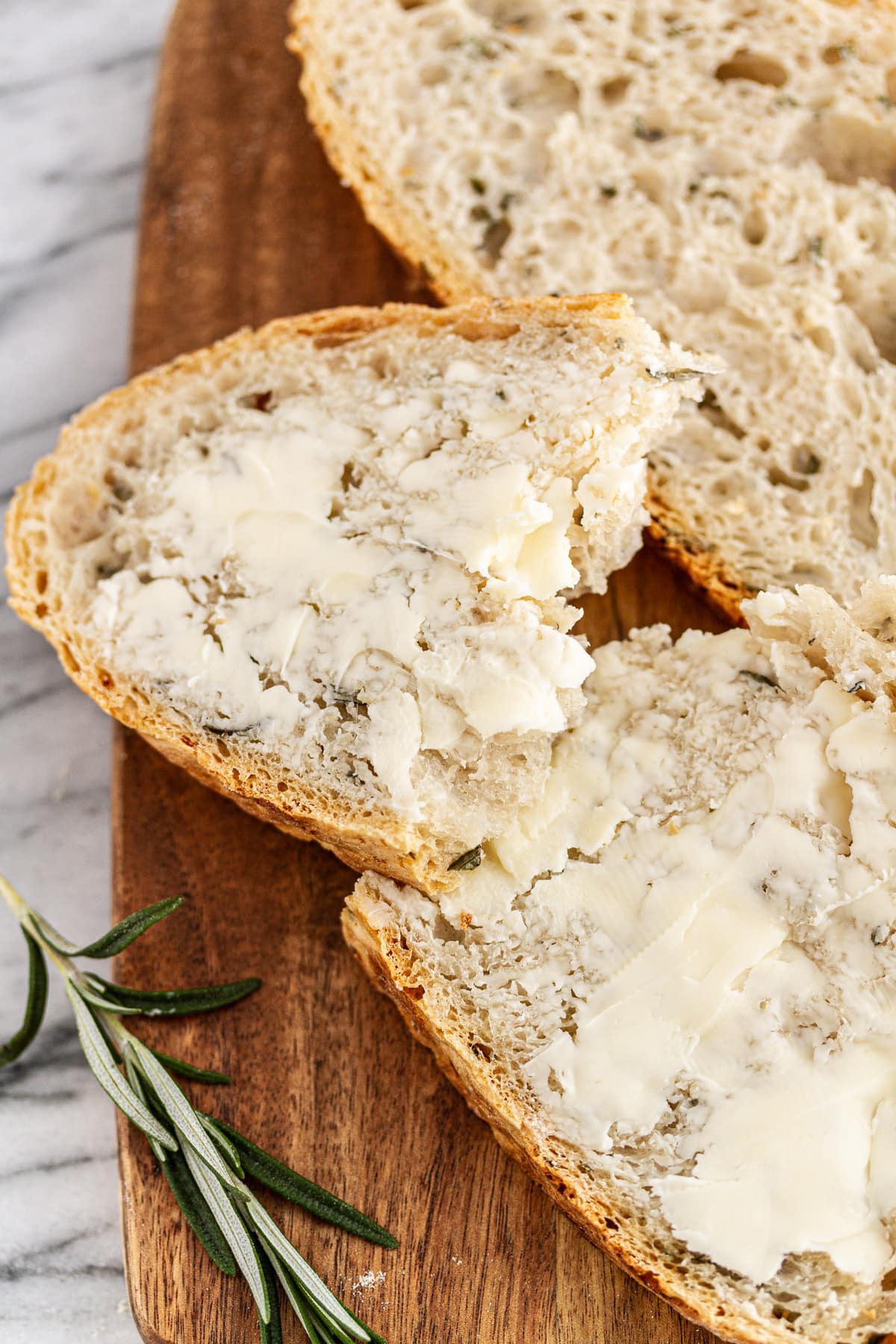
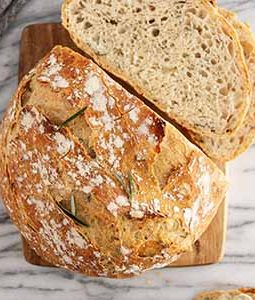
Rosemary-Garlic No-Knead Bread
- Prep Time: 15 minutes
- Cook Time: 1 hour
- Total Time: 9 hours 15 minutes
- Yield: 1 loaf 1x
- Category: Bread
- Method: Bake
- Cuisine: American
Description
The easiest bread you’ll ever bake — now flavored with fresh rosemary and minced garlic for even more yumminess.
Ingredients
- 3 cups all-purpose flour
- 2 teaspoons fine sea salt
- 1 teaspoon active dry yeast
- 3 tablespoons fresh rosemary, roughly chopped
- 3 cloves fresh garlic, minced
- 1 1/2 cups warm water (110°F to 115°F)
Instructions
- In a large bowl, whisk flour, salt and yeast until well mixed; then, whisk in rosemary and garlic. Pour in warm water and use a wooden spoon to stir just until a shaggy dough forms. The mixture will be wet and very sticky to the touch.
- Cover bowl tightly with plastic wrap and set aside in a warm place 8 to 18 hours until dough rises, bubbles and flattens on top.
- Heat oven to 450°F. Once oven is preheated, place a 6-quart Dutch oven (with cover) in oven 30 minutes before baking.
- Punch down dough. Generously flour a sheet of parchment paper; transfer dough to parchment and, with floured hands, quickly shape into a ball. Place dough on parchment paper and sprinkle top lightly with flour. Top with a sheet of plastic wrap and let rest 30 minutes.
- Remove Dutch oven from oven. Uncover dough and carefully transfer to Dutch oven, with or without parchment paper beneath (if bottom of Dutch oven is not coated with enamel, keep parchment paper beneath dough). Cover Dutch oven and return to oven.
- Bake bread 45 minutes covered, then another 10 to 15 minutes uncovered, until dough is baked through and golden brown on top. Cool before slicing.
Notes
- Use fresh rosemary for this recipe. I do not recommend using dried rosemary, as the flavor will not come through well. (I also recommend using fresh garlic, not minced from the jar!)
- Can I preheat an empty Dutch oven safely? That’s a complicated question. According to manufacturers, it is recommended that you don’t do this because your enameled Dutch oven may crack in the oven. HOWEVER, I’ve been baking no-knead bread by preheating the same empty Dutch oven for years and have never had an issue. If you’re concerned about cracking, though, you can try baking no-knead bread using King Arthur Flour’s method of baking in a cold Dutch oven.
- You can store this bread uncovered up to 24 hours, or in a bread box up to 2 days. Once sliced, store the bread sliced-side down on a cutting board at room temperature up to 24 hours (or in a paper bag).
- Looking for the OG recipe? Here’s my very favorite recipe for No-Knead Dutch Oven Bread.
More carbs, please!

I think this would be delicious using roasted garlic cloves too for a sweeter garlic flavor!
I really want to make this, however my Dutch ovens (yep, 2) are 5 qt. round and 5-1/2 qt. oval. Would either of these work?
Hi Jill, Yes, you can use either one! If you use the oval one, you might need to shape the dough into more of an oval shape before placing in the Dutch oven. Happy baking!
I am pinning this no knead bread to try soon. You had be at the no knead part but the rosemary and garlic is what is going to make me actually bake it and not just pin it!
Just tried this bread and it was delicious without a doubt; however there were a couple issues I wish I had answers to! 1. the bread was ectremely tough even after cooling and difficult to slice even wjth a long razor sharp knife. What in the world did I do wrong. My dutch oven is cast iron and a 5 qt. and 2. I let it rise for 8 1/2 hours yet it didn’t seem to rise very much, at least not doubled not even half original size. I used quick rise yease and from a fresh package. I will make this again and maybe discover why it came out soo poorly! Any clues?
Thanks ever so much
Bill, Thanks for the comment! So a tough crust is likely due to temperature issues in the oven. Do you have an oven thermometer? I highly recommend one to accurately gauge the temperature your oven actually is (rather than what it reads on the digital screen). I also recommend using active dry yeast for this recipe, not quick rise/instant yeast (which will have a different measurement). It’s possible your dough actually did rise overnight, but then fell again because the yeast activated and was eaten up too quickly. I hope that helps! I’m glad you enjoyed the taste, anyway. 🙂
Yum,
looks delish and I do adore easier recipes bread as those are the ones I always stick to.
How does this one freeze with garlic in it?
I have 2 foolproof favorite bread recipes on my blog.
https://www.ecoislogical.com/
/Nathalie
Nat, It freezes great, even with the garlic!
I am craving this bread – and I only have a large bag of dry yeast to use – and I’m not sure what to do with it. Do I need to use different measurements to activate the yeast? I see your recipe calls for 1 tsp of yeast here – but in your “how to activate dry yeast” video, it shows activating 2.25 tsp of yeast. Any idea what I should do here? Thank you in advance!
Is there any way to make this if you don’t have a dutch oven?
Carrie, great question! My friend Jessie has a GREAT post on alternative ways to bake bread without a Dutch oven: https://www.lifeasastrawberry.com/crusty-bread-without-dutch-oven/
Can i use INSTANT YEAST if that’s all i have
Yes! If you use instant yeast, only use 3/4 teaspoon (as opposed to 1 teaspoon active dry yeast). But it will work!
My oven is not large enough to fit anything taller than a few inches, could I make two in something like a bread pan, or anything smaller?
Hasn’t gone in the oven yet! But I’m wondering if my dough is too soft and sticky?! Gahhh it’s near impossible to shape into a ball because it just plops back into a fluffy pita bread blob. Have I done something wrong?
I’ve been manoeuvring it lots too to try and shape it. *Cries*
Hello!!
Could I use my sourdough starter for this recipe?
Thanks a lot!
Sofia, Great question! I’m not familiar enough with sourdough starter vs. dry yeast conversions, but I know there are sources out there that probably have info on this (such as King Arthur Flour).
Love love love this recipe!!! It yields some of the best bread I have ever had!!! But I do have a question…I always add the water slowly and I stop when the dough is ‘shaggy’. In all the times I’ve made this bread, I have never used up all the water…Is that normal? Thanks!!!
Gina, Thank you so much! Totally normal to not need all the water… going by feel is always a better bet with bread!
Can I use minced garlic instead of fresh cloves?
Tiffany, Yes!
Love it! Very easy. The hardest part is waiting to bake it.
EM, Thank you! And, agreed. 🙂
This recipe is completely ridiculous. “Quickly shape dough into a ball” how?? The dough was so runny that when I tried to shape it into a ball as best I could and put it on the parchment paper, within a minute it had flattened out. The dough was extremely wet and like sludge, impossible to work with. I kneaded another cup of flour into the dough, and it still was extremely squishy and didn’t hold its shape nearly as much as it needed to.
If you’re looking for a bread recipe and trying to choose which one to go with, I strongly recommend not picking this one. I wish I hadn’t, and am very disappointed that I just wasted all the ingredients I did on a double batch.
Kay, So sorry to hear this recipe didn’t work for you!
I had the same problem but while the bread came out quite flat it’s still very tasty. I’m gonna try to add less water next time and see what happens.